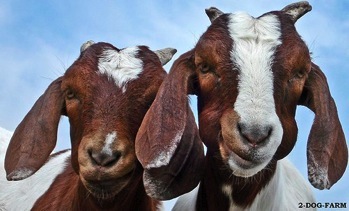Nutrition

“I’m Hungry! What’s For Dinner?”
Capra hircus is a grazing herbivore. It is a diurnal animal (is active during the day), so it spends a large majority of the day grazing to obtain its food. Typically, Capra hircus grazes on grasses, weeds, tree bark, meadow and cultivated fodder (feed), leafy and needled branches, hay and silage.
Once ingested, these materials pass into the
goat’s four-chambered stomach. First, the
food enters the rumen. This chamber can
hold up to 10 ½ quarts of food and
contains bacteria and microorganisms that
are capable of breaking down cellulose into
fatty acids. These fatty acids can be
absorbed into the blood and later utilized
by the goat’s cells. To maintain these
bacteria and microorganisms, the goat’s
diet must contain albumin, a protein. This
protein is supplied by the typical foods of
the goat.
For more information on the bacteria,
see Interactions with other Species.
In addition to the breaking down
cellulose, the goat’s rumen also
helps to mechanically break
down the food. The roughage that
the goat ingests stimulates
regurgitation, and the goat
regurgitates a mouthful of the
ingested food and re-chews it.
This process is commonly known
as cud chewing.
To watch a video of a goat chewing
its cud, click here.
After leaving being broken down in the rumen, the food passes through the reticulum and omasum chambers and into the “true stomach”, which is also known as the abomasum or rennet. This chamber contains hydrochloric acid and digestive enzymes that further digest the food before it passes into the intestine. This chamber is very similar to the stomachs of humans and other non-ruminates.
Once the food is broken down into its molecular components, it passes into the small intestine where nutrients are absorbed through the intestinal wall into the blood stream. These nutrients are carried through a closed circulatory system to cells in specific tissues where they are converted to glucose to be used for cell metabolism. Unused glucose is then converted to glycogen and stored for later use.
In some cases Capra hircus can serve as a host for certain parasites. The goats eat the larvae of these worms with their food and then excrete their eggs in the fields where they graze. Because of the proximity of their food to their excretions this parasite host relationship is common.
For more on goat-parasite relationships, see Interactions with Other Species.
To learn about the goat’s life history and reproduction, click here.
To return home, click here.
Diagram of the goat’s four stomach Chambers.
Image courtesy of the New South Wales Department of Primary Industries
Two goats chewing their cud.
Image by 2-Dog-Farm










